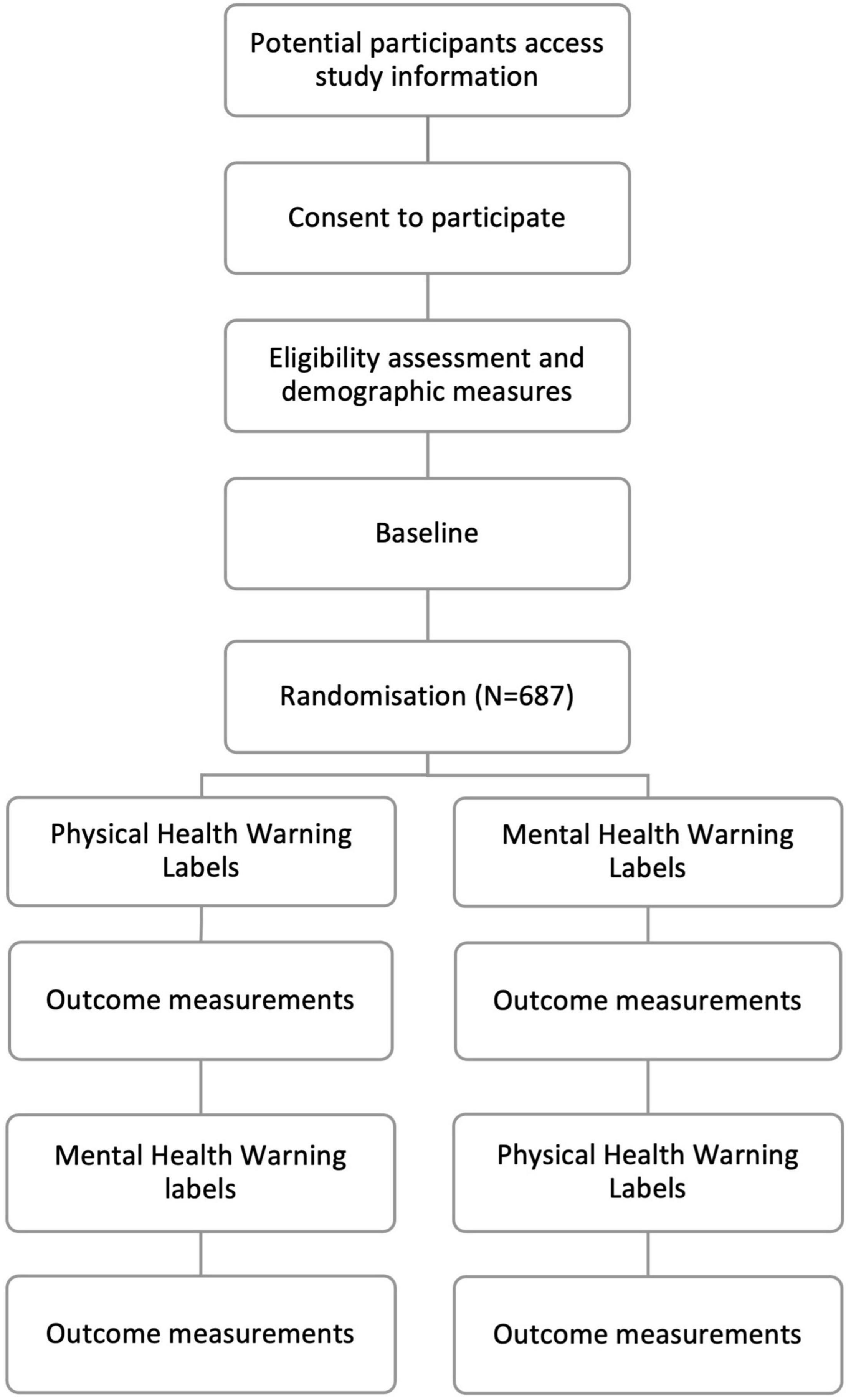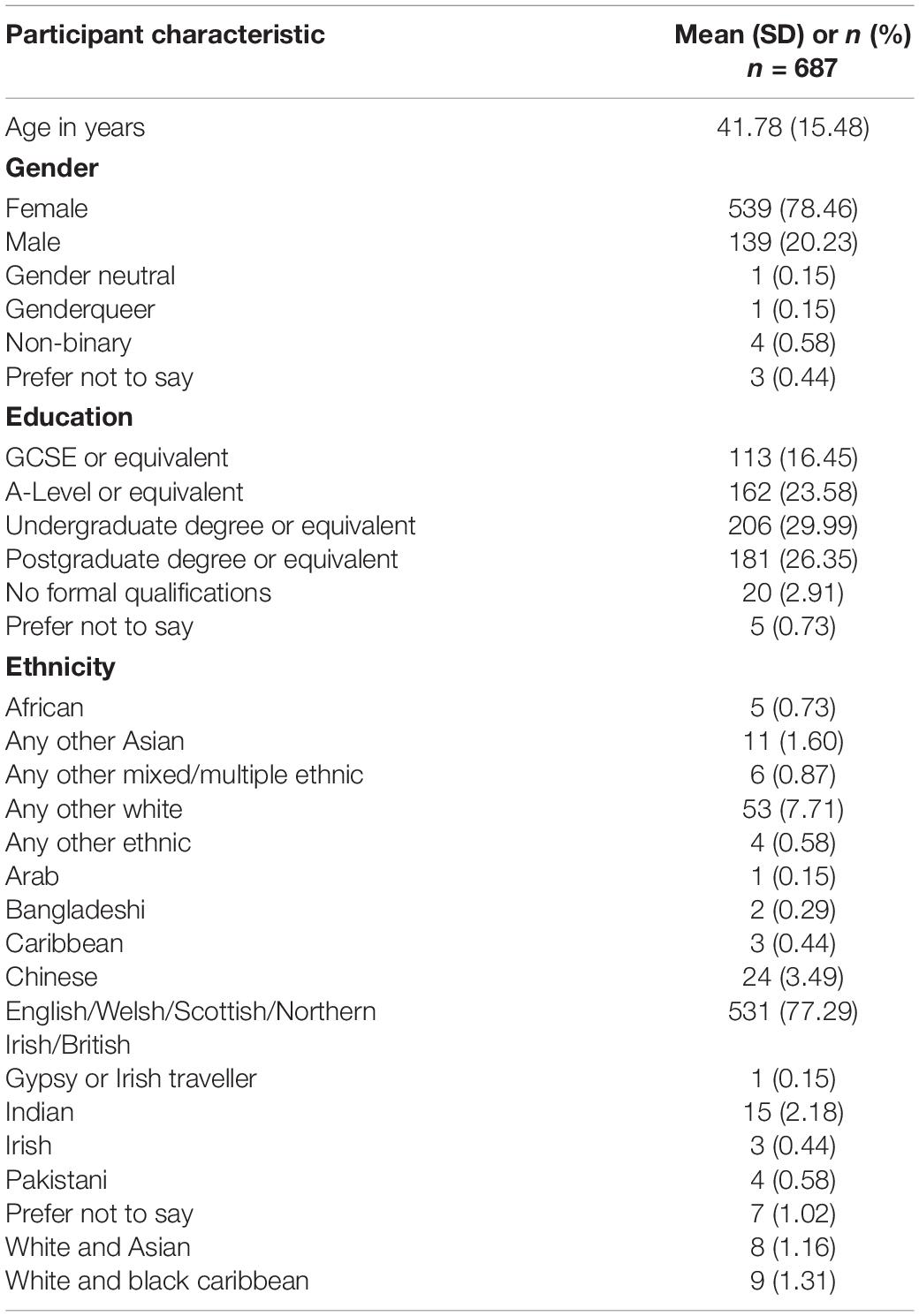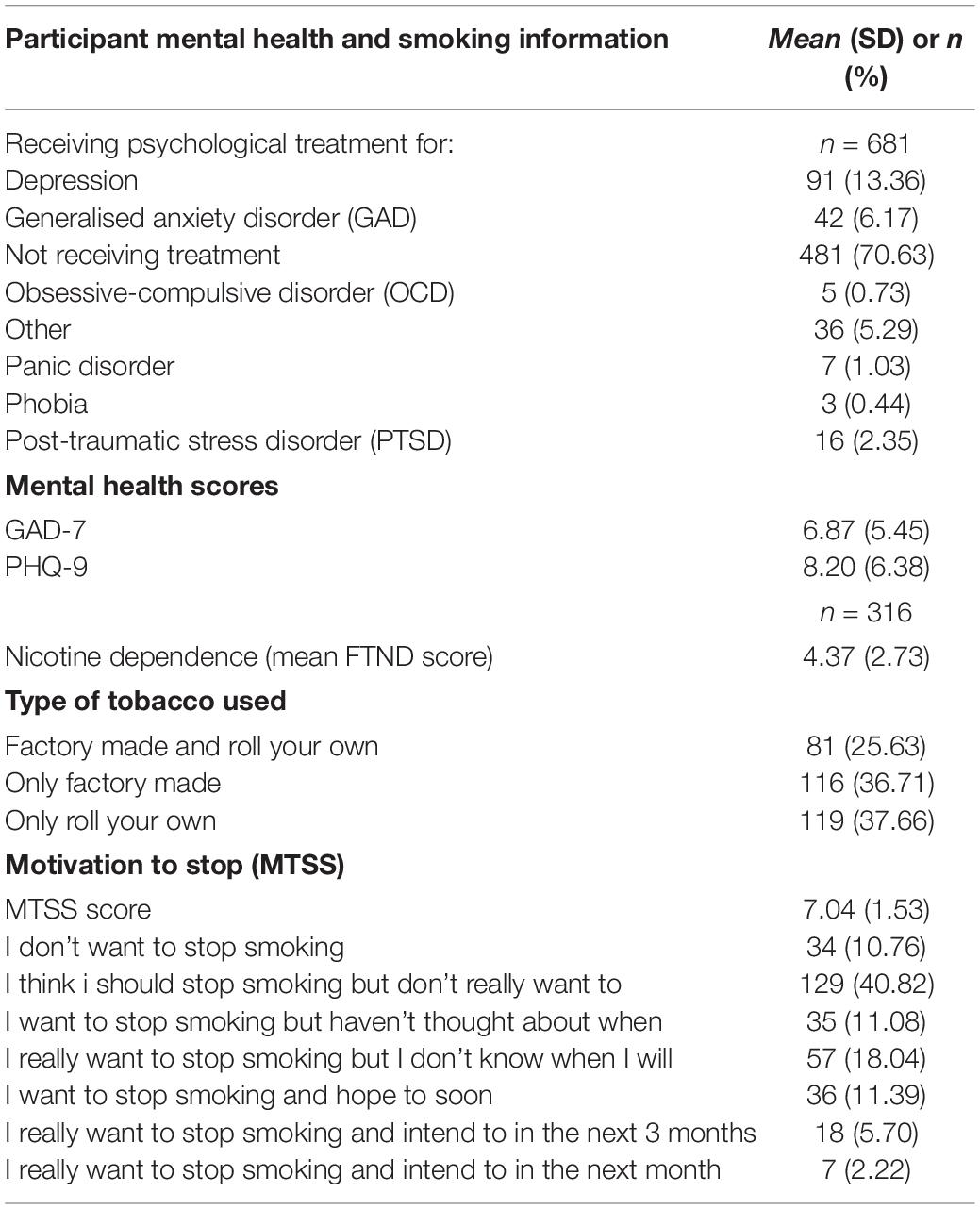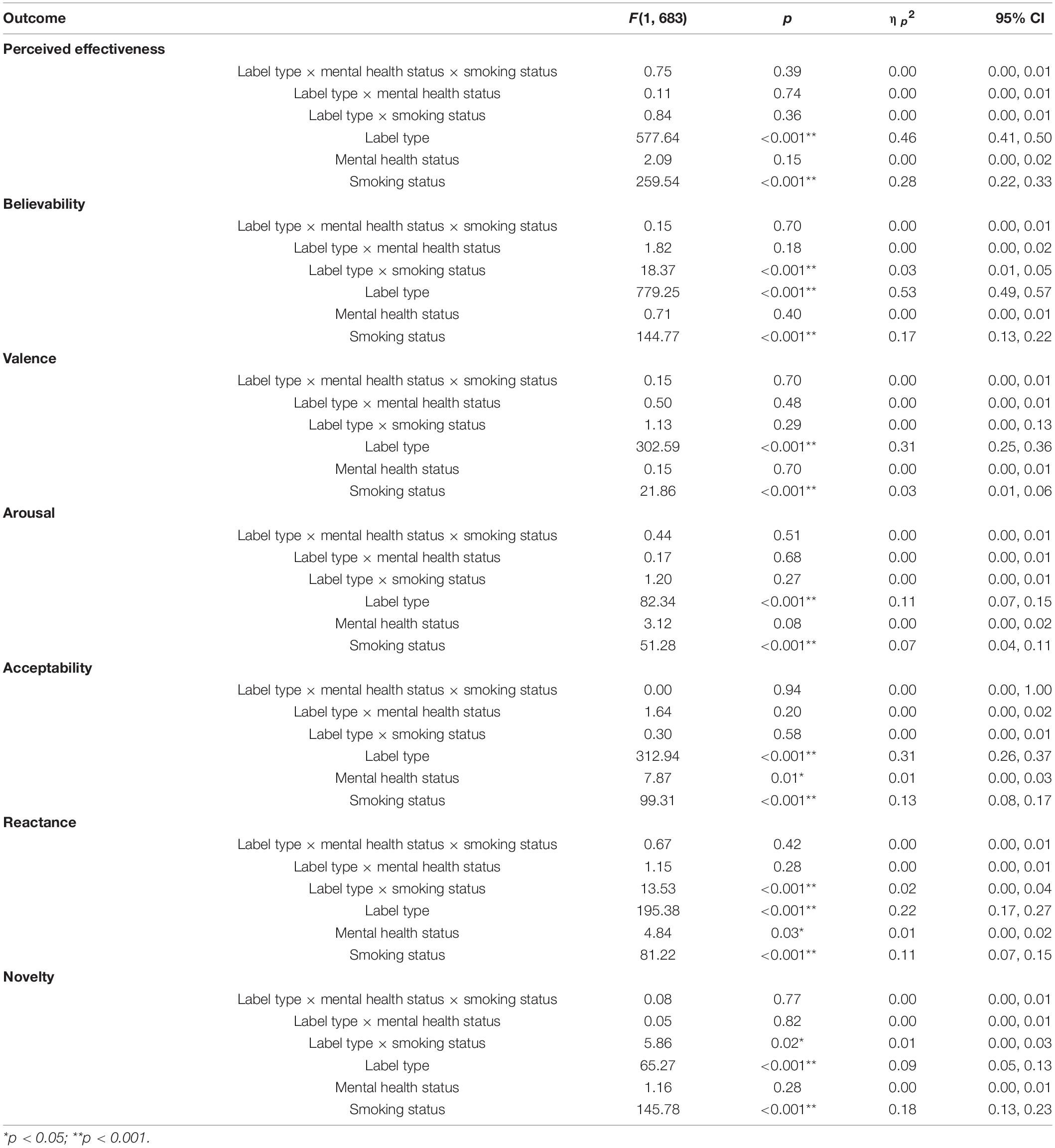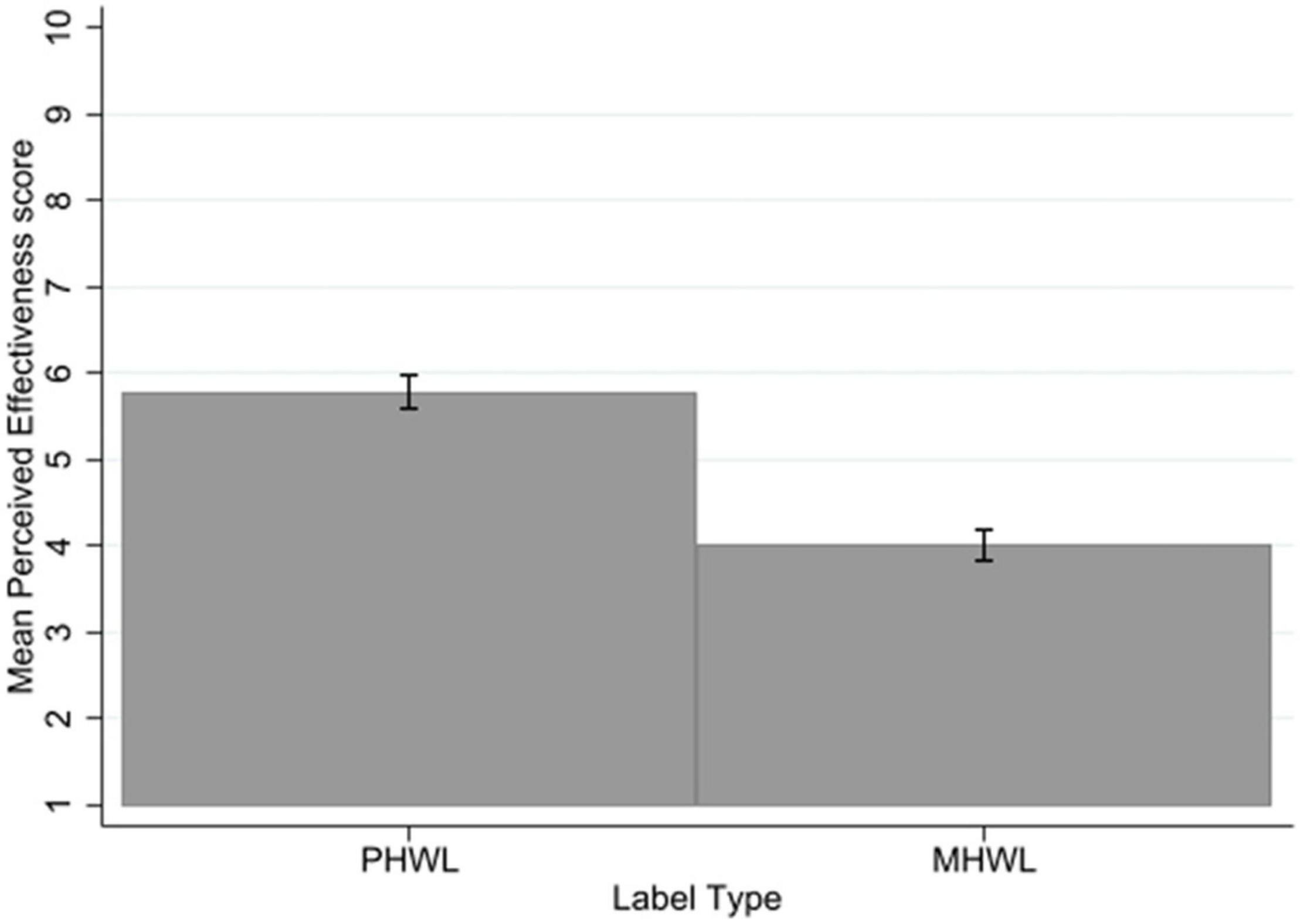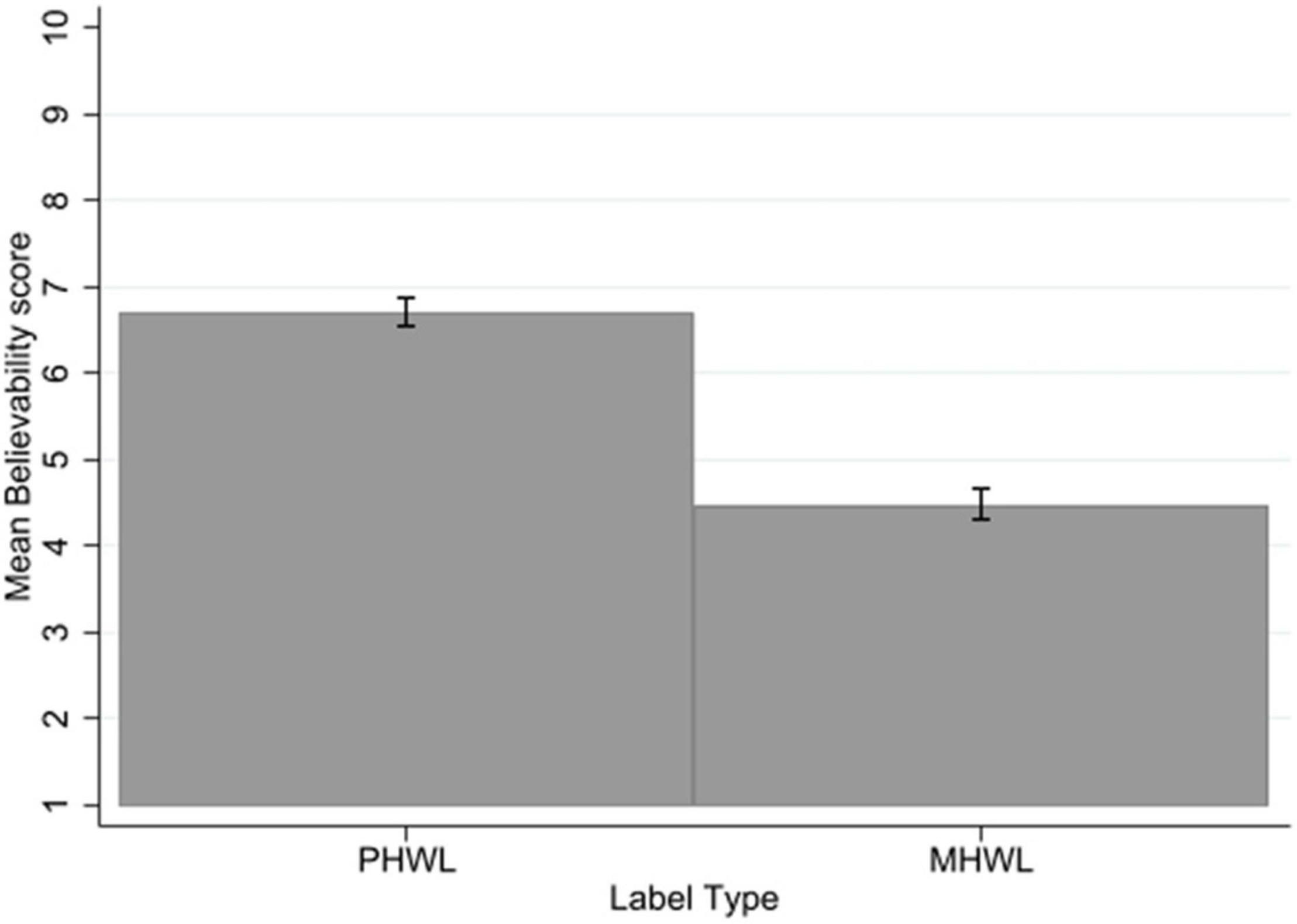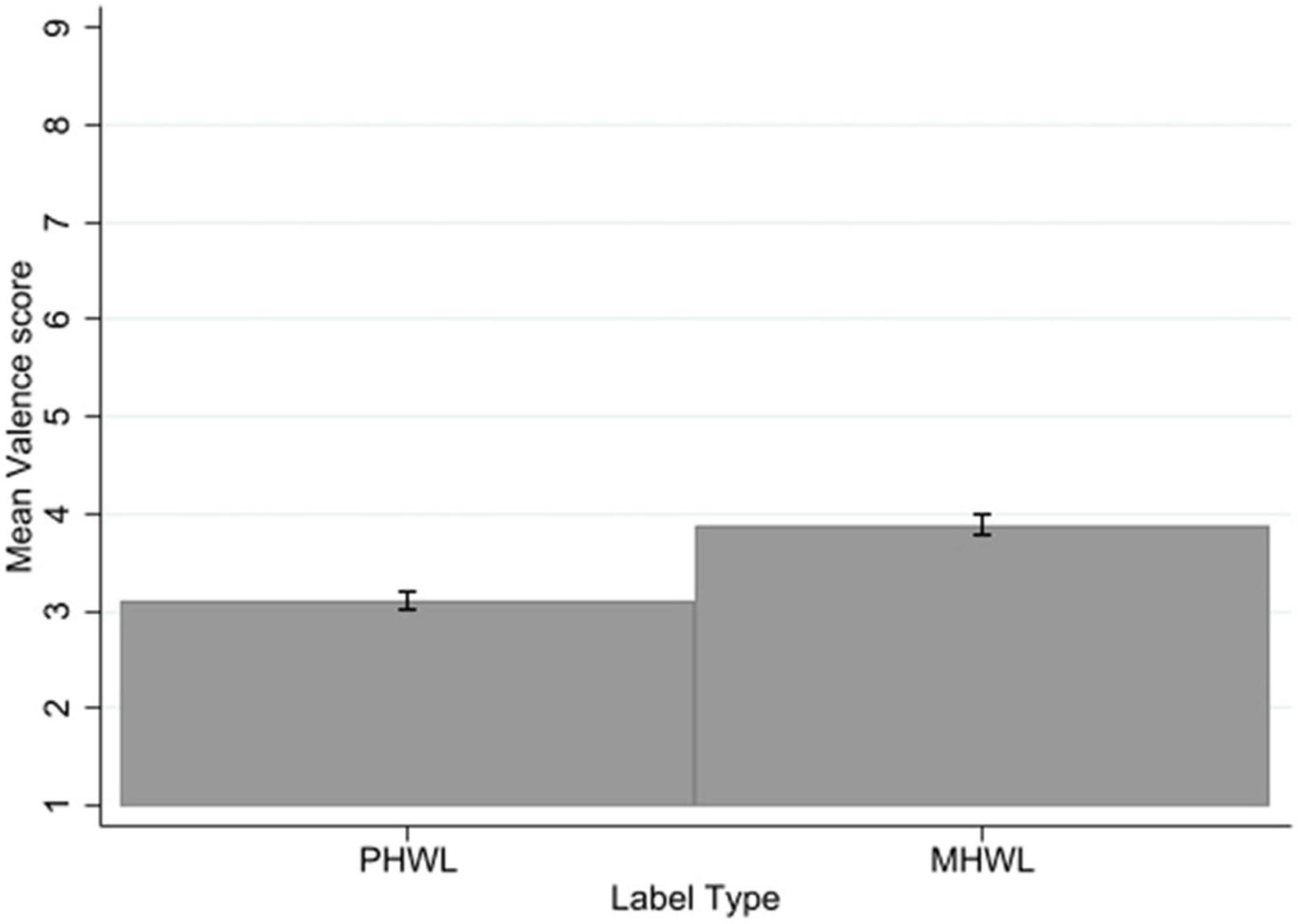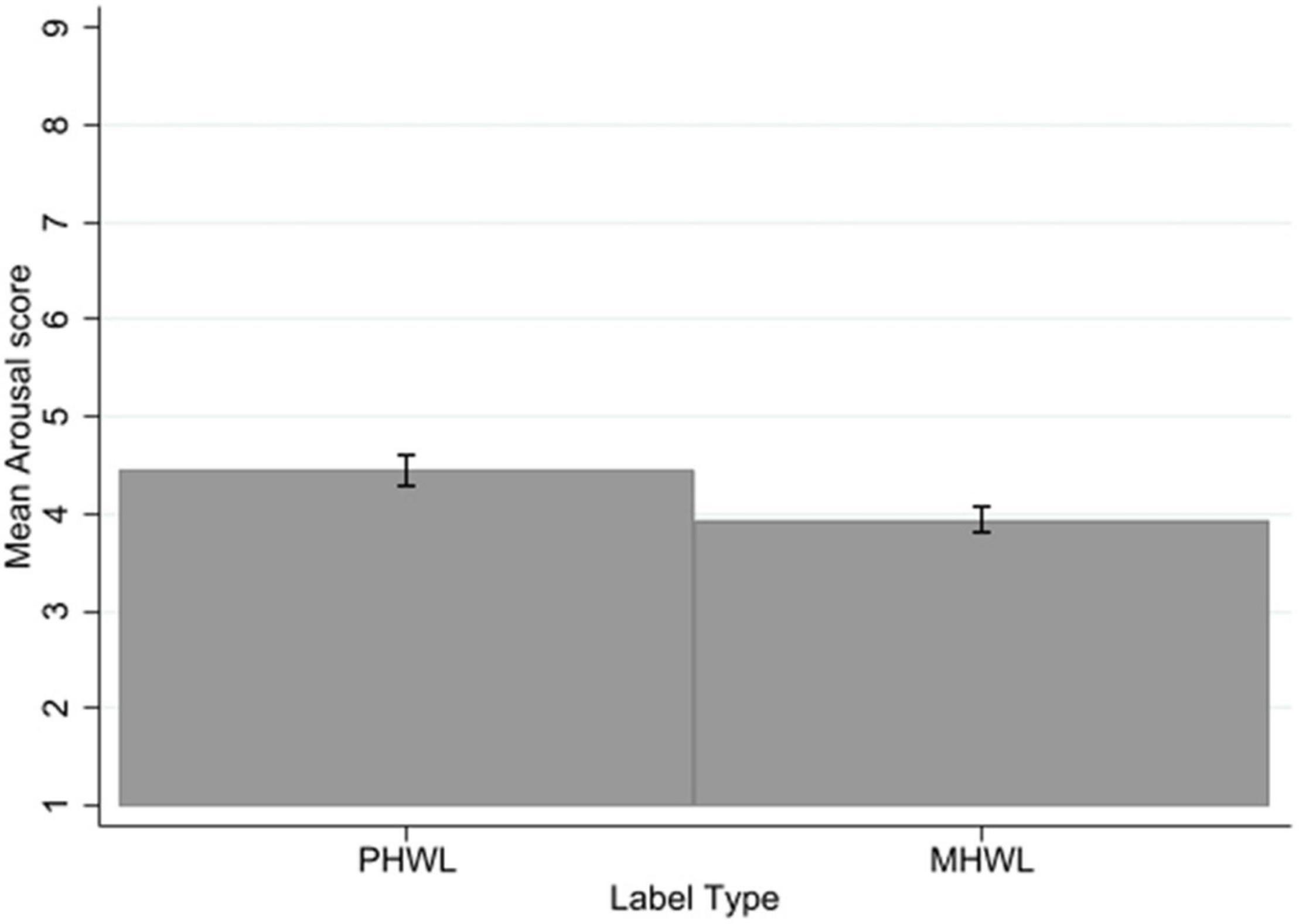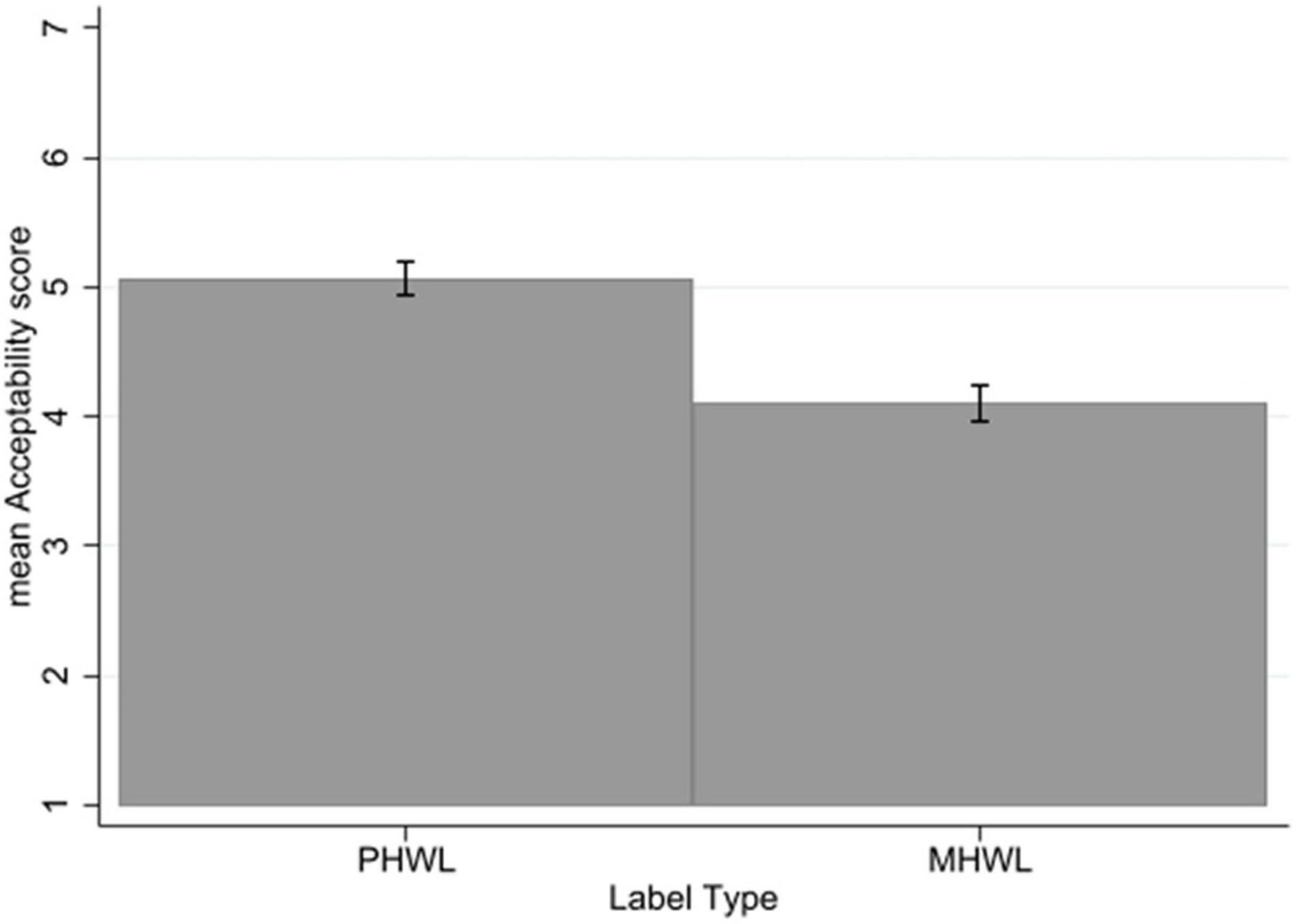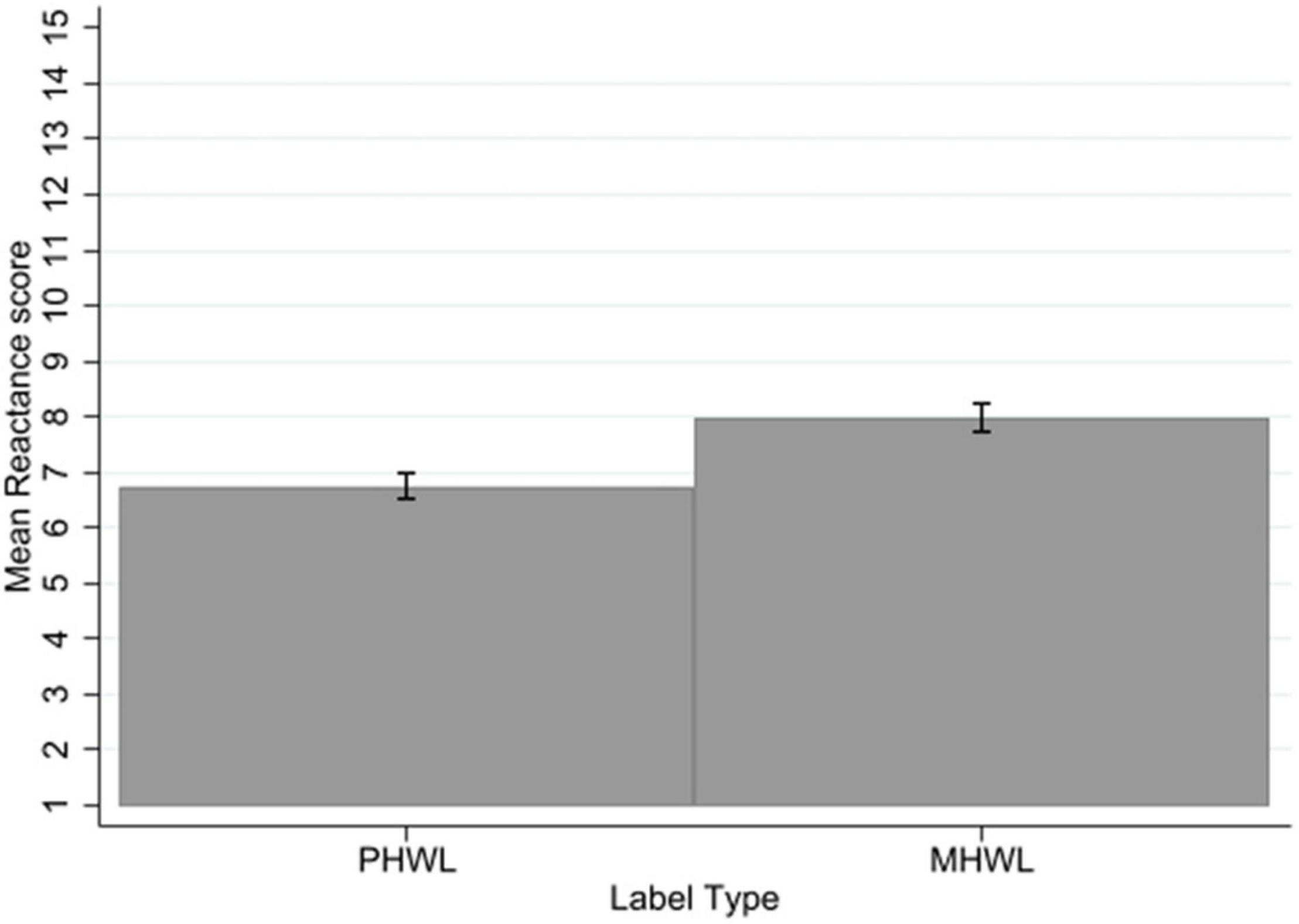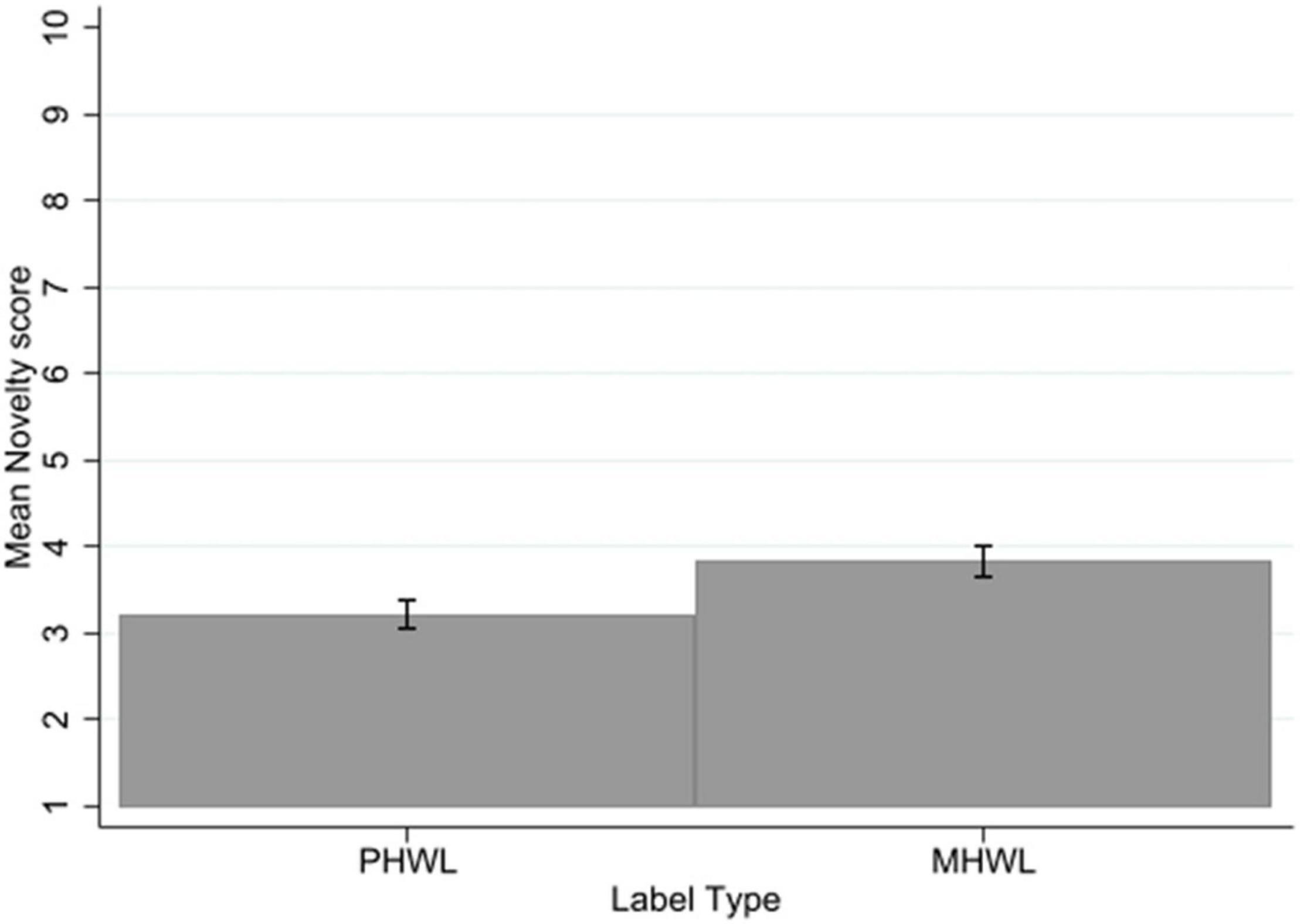- 1Addiction and Mental Health Group (AIM), Department of Psychology, University of Bath, Bath, United Kingdom
- 2Institute for Mental Health, University of Birmingham, Birmingham, United Kingdom
Background: Health warning labels on tobacco packaging are a cost-effective means of health risk communication. However, while an extensive range of physical health risks are well-portrayed via current tobacco health warnings in the UK, there are none that currently portray the negative impact of smoking on mental health.
Aims: (i) develop novel mental health warning labels for tobacco packaging and (ii) test perceptions of these warnings in smokers and non-smokers, with and without mental health problems.
Methods: Six mental health warning labels were developed with a consultancy focus group. These warning labels were tested in an online randomised experiment, where respondents (N = 687) rated six Mental Health Warning Labels (MHWLs) and six Physical Health Warning Labels (PHWLs) on measures of perceived effectiveness, believability, arousal, valence, acceptability, reactance and novelty of information.
Results: MHWLs were perceived as low to moderately effective (mean = 4.02, SD = 2.40), but less effective than PHWLs (mean = 5.78, SD = 2.55, p < 0.001, ηp2 = 0.63). MHWLs were perceived as less believable, arousing, unpleasant, and acceptable than PHWLs. MHWLs evoked more reactance and were rated as more novel. Perceptions of MHWLs did not differ in people with and without mental health problems except for reactance and acceptability, but consistent with the PHWL literature, perceptions of MHWLs differed between non-smokers and smokers.
Conclusion: MHWLs could be an effective means to communicate novel information about the effects of smoking on mental health. MHWLs are perceived as less effective, believable, arousing, unpleasant, and acceptable than PHWLs, but MHWLs evoke more reactance and are rated as more novel.
Introduction
Smoking is the leading cause of preventable death and illness in the UK (1), with 77,800 deaths per year estimated to be attributable to smoking (2). In high income countries, smoking rates have declined among the general population (3, 4). However, people with common mental health conditions such as anxiety and depression, are twice as likely to smoke than the general population (5, 6). Smokers with mental health conditions encounter substantial barriers to cessation, such as heavier smoking and greater nicotine dependence and withdrawal symptoms (7–10). People with mental health conditions die 10–20 years younger than the general population, and smoking is a primary reason for this (11, 12). Smoking represents a major driver of health inequalities and there have been calls from governments and healthcare agencies for bespoke and targeted interventions for people with mental health conditions (4, 13).
It is well established that smoking damages physical health, and warning labels on tobacco packaging are a cost-effective method of communicating these health risks (14). In 2017, the UK implemented plain tobacco packaging with pictorial warnings (15). There is an extensive range of physical health risks portrayed on tobacco health warning labels in the UK and internationally (16), which are demonstrated to be effective in promoting smoking cessation, and reducing smoking uptake (14, 17, 18). However, it is less well known amongst the general public and healthcare professionals that smoking can negatively affect mental health (19–21). A large body of evidence suggests that tobacco use increases the risk of developing depression, schizophrenia and bipolar disorder (22–25), and that smoking cessation can reduce symptoms of depression, anxiety, and stress, and lead to improved wellbeing and positive feelings (26). Qualitative research suggests that people who smoke and have mental health conditions “buy in” to the idea that tobacco can worsen mental health, they understand that smoking can make their depression and anxiety worse, and that quitting could improve their mental health (27). Hence, mental health warnings on tobacco packaging represent a key strategy to promote smoking cessation and prevent uptake, by, for example, increasing understanding and believability of the link between smoking and mental health, or increasing arousal when viewing tobacco warning labels.
The World Health Organisation (WHO) recommends that warnings on tobacco packaging should expand to include the risks of smoking for mental health (28), however, only one country has adopted this recommendation, and there is only one study testing the effectiveness of one MHWL. Columbia introduced one mental health warning in 2018 describing the effects of smoking on anxiety, and found larger warnings decrease positive pack perceptions and have the potential to reduce the demand for tobacco products (29). Other than this one study, no other countries have adopted this recommendation, and there are no other research testing the effectiveness of such warning labels. Notably, limited empirical research suggests that pictorial mental health warnings for cannabis products are perceived as moderately effective and believable (30). Some evidence suggests that smokers with mental health conditions might respond differently than other populations to tobacco warning messages (31, 32). Smokers with mental health conditions are more likely to perceive physical health warnings as more effective (31), and exhibit greater attention and cognitive responses to health warning labels (32). However, people with mental health conditions are also more likely to avoid looking at the health warning label (32).
Therefore, this study aims to develop novel mental health warning labels for tobacco packaging and to address the following exploratory research questions:
1. Are Mental Health Warning Labels (MHWLs) rated differently to Physical Health Warning Labels (PHWLs) on measures of perceived effectiveness, believability, arousal, valence, acceptability, reactance, novelty of information, and potential effectiveness?
2. Do ratings of warning labels differ according to smoking status or mental health status?
3. Does the difference in ratings between PHWLs and MHWLs vary according to smoking status or mental health status?
Materials and Methods
The protocol was pre-registered on the Open Science Framework (OSF) (DOI 10.17605/OSF.IO/37X56). Ethical approval was obtained from the Psychology Research Ethics Committee (PREC) at the University of Bath on 27/April/2020 (PREC ID 20-028). Consultation with service users and members of the public has shaped the methodology proposed. Additional information on study methods is provided in Supplementary Material 1.
Study Design and Setting
This study was an online, randomised experiment with a 2 × 2 × 2 design. Mental health status (people with common mental health disorders vs. people without common mental health disorders) and smoking status (smokers vs. non-smokers) were between subjects’ variables, and type of tobacco health warning (MHWLs vs. PHWLs) was a within subjects’ factor. Warnings were presented in a randomised order, randomised in blocks (with PHWLs and MHWLs constituting each one block) and the order of specific warnings within each block also randomised.
Participants and Recruitment
Participants were recruited via email lists, third-sector services, public engagement events, social media, and PROLIFIC.1 Participants were aged 18 years or greater, UK residents, able to read English. We also targeted males when we realised that we had a disproportionate number of females. Our sample is comparable to large scale studies of smokers in the UK in terms of sex, age, and tobacco dependency (33). Smokers were those self-reported to smoke at least 100 cigarettes during their lifetime, and at the time of participating in the survey smoking at least once per week (34). Non-smokers were those self-reported to have smoked at least 100 cigarettes during their lifetime, and at the time of participating in the survey not currently smoking. Having a common mental health condition was defined as scoring above clinical cut-off scores on the GAD-7 (35) and the PHQ-9 (36) [score of ≥ 8 on the GAD-7 (35, 37, 38) and/or ≥ 10 on the PHQ-9 (36)], currently receiving treatment for a mental health problem was not used as grouping criteria.
Power Calculation
A priori power was calculated using G*Power. To achieve 95% power at 5% alpha level to determine a small effect size of f = 0.1 on our primary outcome (effectiveness), we needed 608 participants. A study by Maynard et al. (39) used to guide some measures in this study, examining the difference in perceived effectiveness of tobacco warning labels between smokers and non-smokers, reported a η2 of 0.04, which corresponds to an effect size of f = 0.2 (40). Given that mental health warnings are not established and are untested in this population, we implemented a more conservative effect size for this power calculation (f = 0.1).
Stimuli
Warning labels were presented as pictorial and text warning together in a stacked format, as in accordance with EU guidance, with a size of 300 by 300 pixels (16).
The final set of MHWLs to be implemented in the online experiment was guided by a patient and public consultancy group. The MHWLs were informed by causal evidence of the effect of smoking on mental health (22–25). The MHWLs were approved by three members of the public with lived experience of smoking and/or mental health in a consultancy focus group, which involved deep discussions around both the text and pictures to be selected for the current study. For more information on development please see the preregistered protocol (DOI 10.17605/OSF.IO/37X56). The MHWLs presented were: “Smoking increases the risk of schizophrenia,” “Smoking harms your mental health,” “Smoking increases the risk of depression,” “Smoking increases anxiety and tension,” “Smoking increases the risk of bipolar disorder” and “Smoking makes stress worse,” due to copyright, stimuli are available on request from the primary author.
PHWLs were selected from set 2 of the European Union pictorial warnings (16). Images from set 2 were chosen due to rotation date occurring at the start of recruitment (May 2020). The following warning labels were selected: “Smoking causes 9 out of 10 lung cancers,” “Smoking increases the risk of blindness,” “Smoking damages your teeth and gums,” “Smoking causes heart attacks,” “Smoking causes stroke and disability,” “Smoking clogs your arteries,” due to copyright, stimuli are available on request from the primary author.
Primary Outcome Measures
Effectiveness
Potential effectiveness of tobacco health warning labels was assessed by a measure adapted from Pechey et al. (41): “Does this affect how much you want to have a cigarette right now?,” answered on a visual 1–7 Likert scale, with 1 labelled as “not at all” and 7 labelled as “very much.” This question was only presented to smokers.
Perceived effectiveness of tobacco health warning labels was assessed by a measure adapted from Maynard et al. (39): “Overall, on a scale of 1–10, how effective is this health warning? (e.g., in encouraging smokers to quit, increasing concerns about smoking, and discouraging youth from starting to smoke)”, with 1 as not at all and 10 as extremely.
Secondary Outcome Measures
Believability
Believability was assessed by asking “Overall, on a scale of 1–10, how believable is this health warning?” The questions was answered on a visual 1–10 Likert scale, with 1 labelled as “not at all” and 10 labelled as “extremely” (39).
Valence and Arousal
Emotional response to the health warning labels was assessed using the valence and arousal items of the Self-Assessment Manakin (SAM) (31, 42). Respondents rated their affective states on 9-point visual analogue scales for valence, ranging from 1 “unpleasant” to 9 “pleasant,” and arousal, ranging from 1 “calm” to 9 “agitated,” with 5 as neutral. Note that “agitated” replaced “excited” as this was deemed more appropriate in this study context.
Acceptability
Acceptability of tobacco health warning labels was assessed by asking “Do you support or oppose putting this label on tobacco products?” on a visual 1–7 Likert scale, with 1 labelled as “strongly oppose” and 7 labelled as “strongly support.” Adapted from previous research assessing alcohol health warning labels (41). Participants were also asked to provide a response in a free-text box to the question “Why do you support/oppose putting the label on tobacco products?”
Reactance
Reactance to health warning labels was assessed using the Brief Measure of Reactance to Health Warnings Scale (RHWS) (43). Respondents were asked “Please state how much you agree or disagree with each statement about the health warning presented above” in response to “The health effect on this warning is overblown,” “This warning is trying to manipulate me” and “This warning annoys me” on a visual 1–5 Likert scale, with 1 labelled as “strongly disagree” and 5 labelled as “strongly agree.” Scores were summed to give an overall total reactance score.
Novelty of Information
To assess novelty of information participants were asked: “Have you learned something new from this packaging about the effects of smoking cigarettes on health and wellbeing?” on a visual Likert scale of 1–10 with 1 labelled as “not at all” and 10 labelled as “extremely.” Respondents were then asked to “Please briefly describe your response in the box below.”
Qualitative Data
Adapted from Pechey et al. (41), after each block of warning label type participants were presented with an open-text comment box and asked, “Do you have any further thoughts or comments that you would like to add about the last 6 health warnings you viewed?”
Additional Measures
We collected data about age, gender, level of education, ethnicity, and country of residence. Smoking status was screened by asking respondents “Have you smoked at least 100 cigarettes in your lifetime?” (Yes/No), and “How often do you smoke cigarettes?” (every day, every week, less than every week or not at all) (34). Fagerström Test of Nicotine Dependence (FTND) was used to assess nicotine dependence of smokers only (44); smokers were asked the type of cigarette smoked (45), and smokers motivation to stop smoking were assessed by the Motivation To Stop Scale (MTSS) (46, 47).
The GAD-7 and PHQ-9 were used to assess having depression or anxiety. For demographic information only participants were also asked if they were receiving treatment for a mental health condition: “Are you currently undergoing treatment (psychological or medical) for a mental health condition?” This question was used to describe the sample characteristics and not for inclusion or grouping criteria.
Procedure
The complete experiment, including screening, consent, and randomisation, was implemented online using Qualtrics.2 Following consent, participants completed screening questions and quota items. Participants were asked to rate a series of 12 tobacco health warning labels, 6 of each warning label type (see Figure 1). Participants were debriefed and informed about how be contacted about study findings and/or enter the study prize draw for the chance to win a £50 Amazon Voucher (538 people entered).
Randomisation
Random Allocation and Sequence Generation
Participants were randomly assigned to view either the MHWLs first and then the PHWLs or the PHWLs then the MHWLs with a 1:1 allocation. The order of 6 warnings within each block was also randomised. The random sequence was generated using Qualtrics computer software embedded simple randomisation functions.
Allocation Concealment Mechanism
Participants were randomised using Qualtrics, allocation was concealed as the randomised sequence was not recorded and so was unavailable to the research team. The research team were blind to the randomisation order of both blocks and individual warnings within each block.
Implementation
Randomisation was implemented using Qualtrics randomisation function, Qualtrics generated the allocation sequence, assigned participants to each order after participants completed consent questions on Qualtrics. Randomisation only occurred after participant identifier, eligibility and consent had been recorded to ensure that implementation was not influenced by the research team or the participants.
Statistical Analysis
Data were analysed using Stata IC, do-files will be made available on OSF. Dummy variables were generated to indicate participants’ smoking and mental health status. Prior to analyses, composite measures for MHWLs and PHWLs were generated to assess the warning label types, these were created using mean ratings across each health outcome in each label group, for each measure. 2 × 2 × 2 mixed ANOVAs were performed, with mental health condition and smoking status as between-groups factors and health warning label type as a within-groups factor. Label type, mental health status and smoking status were independent variables and perceived effectiveness, believability, arousal, valence, acceptability, reactance, novelty of information were dependent variables.
Free-text questions were manually coded by two authors using content analysis with verbatim responses coded into a small set of meaningful categories. The results of this analysis are reported elsewhere.
Missing Data
Forced responses on all primary and secondary measures were implemented via Qualtrics to limit missing data. The qualitative, free-text questions were optional responses.
Protocol Deviations
Midway through the active survey the measure of Potential effectiveness was identified as being without direction and coded incorrectly, therefore was excluded from the analysis. Although we aimed to have balanced groups an error in the Qualtrics survey quota requirements led to unbalanced group sizes.
Results
Characteristics of Participants
A total of 687 participants took part in the study, 371 were non-smokers, 316 were smokers, 372 did not have a mental health problem, 315 did have a mental health problem. Across combined groups 219 were non-smokers without mental health problems, 152 were non-smokers with a mental health problem, 153 were smokers without a mental health problem, 163 were smokers with a mental health problem. The mean age was 41.78 (SD = 15.48), and 78.46% (n = 539) were females, details of participant characteristics are displayed in Tables 1, 2. Results are presented in Table 3.
Perceived Effectiveness
There was no significant three-way interaction of label type × mental health status × smoking status for perceived effectiveness. There was no significant interaction of label type with mental health status, or label type with smoking status.
There was a significant main effect of label type on perceived effectiveness with a large effect size (p < 0.001, ηp2 = 0.46) with PHWLs perceived as being more effective (mean = 5.78, SD = 2.55) than MHWLs (mean = 4.02, SD = 2.40) across the sample (Figure 2).
There was no significant main effect of mental health status on perceived effectiveness, people without mental health problems (mean = 5.11, SD = 2.61) did not differ from people with mental health problems (mean = 4.65, SD = 2.61) in their perceptions of effectiveness of the tobacco warning labels. There was a significant effect of smoking status on perceived effectiveness with a large effect size (p < 0.001, ηp2 = 0.28), with non-smokers perceiving labels as more effective (mean = 6.01, SD = 2.32) than smokers (mean = 3.60, SD = 2.34) (see Supplementary Figure 1).
Believability
There was no significant three-way interaction of label type × mental health status × smoking status for believability. There was no significant interaction of label type with mental health status. There was a significant interaction of label type and smoking status with a small to moderate effect size (p < 0.001, ηp2 = 0.03). Bonferroni corrected post-hoc t-tests, indicate that smokers rated MHWLs as less believable than PHWLs (−2.61, SE = 0.17, p < 0.001, 95% CI [−3.07, −2.16]) to a greater extent than non-smokers (−1.98, SE = 0.16, p < 0.001, 95% CI [−2.31, −1.47]).
There was a significant main effect of label type on believability with a large effect size (p < 0.001, ηp2 = 0.53) with PHWLs rated as more believable (mean = 6.70, SD = 2.25) than MHWLs (mean = 4.48, SD = 2.44) across the sample (Figure 3).
There was no significant main effect of mental health status on believability, people without mental health problems (mean = 5.73, SD = 2.58) did not differ from people with mental health problems (mean = 5.43, SD = 2.61). There was a significant main effect of smoking status on believability with a large effect size (p < 0.001, ηp2 = 0.17), with non-smokers rating labels as more believable (mean = 6.40, SD = 2.24) than smokers (mean = 4.61, SD = 2.67) (see Supplementary Figure 2).
Valence
There was no significant three-way interaction of label type × mental health status × smoking status for valence. There was no significant interaction of label type with mental health status, or label type with smoking status.
There was a significant main effect of label type on valence, with a large effect size (p < 0.001, ηp2. = 0.31) with PHWLs rated as more unpleasant (mean = 3.11, SD = 1.26) than MHWLs (mean = 3.89, SD = 1.30) across the sample (Figure 4).
There was no significant main effect of mental health status on valence, people without mental health problems (mean = 3.49, SD = 1.35) did not differ from people with mental health problems (mean = 3.50, SD = 1.33). There was a significant main effect of smoking status on valence, with a small to moderate effect size (p < 0.001, ηp2 = 0.03), with non-smokers rating labels as more unpleasant (mean = 3.31, SD = 1.28), than smokers (mean = 3.72, SD = 1.38) (see Supplementary Figure 3).
Arousal
There was no significant three-way interaction of label type × mental health status × smoking status for arousal. There was no significant interaction of label type with mental health status or label type with smoking status.
There was a significant main effect of label type on arousal with a medium to large effect size (p < 0.001, ηp2 = 0.11), with PHWLs were rated as more arousing (mean = 4.45, SD = 1.97) than MHWLs (mean = 3.94, SD = 1.87) across the sample (Figure 5).
There was no significant main effect of mental health status on arousal, people without mental health problems (mean = 4.13, SD = 1.97), did not differ from people with mental health problems (mean = 4.27, SD = 1.90). There was a significant main effect of smoking status on arousal, with a medium effect size (p < 0.001, ηp2 = 0.07), with non-smokers rating labels as more arousing (mean = 4.62, SD = 1.86) than smokers (mean = 3.69, SD = 1.91) (see Supplementary Figure 4).
Acceptability
There was no significant three-way interaction of label type × mental health status × smoking status for acceptability. There was no significant interaction of label type with mental health status or label type with smoking status.
There was a significant main effect of label type on acceptability with a large effect size (p < 0.001, ηp2 = 0.31) with PHWLs rated as more acceptable (mean = 5.07, SD = 1.68) than MHWLs (mean = 4.10, SD = 1.80) across the sample (Figure 6).
There was a significant main effect of mental health status on acceptability (p = 0.01, ηp2 = 0.01). People without mental health problems (mean = 4.79, SD = 1.76) rated labels as more acceptable than people with mental health problems (mean = 4.35, SD = 1.83). There was a significant main effect of smoking status on acceptability with a large effect size (p < 0.001, ηp2 = 0.13). Non-smokers rated labels are more acceptable (mean = 5.12, SD = 1.53) than smokers (mean = 3.96, SD = 1.90) (see Supplementary Figure 5).
Reactance
There was no significant three-way interaction of label type × mental health status × smoking status for reactance. There was no significant interaction of label type with mental health status. There was a significant interaction of label type with smoking status (p < 0.001, ηp2 = 0.02). Bonferroni corrected post-hoc t-tests, indicate that smokers rated MHWLs as evoking more reactance than PHWLs (1.62, SE = 0.24, p < 0.001, 95% CI [0.98, 2.26]) to a greater extent than non-smokers (0.91, SE = 0.22, p < 0.001, 95% CI [0.32, 1.50]).
There was a significant main effect of label type on reactance with a large effect size (p < 0.001, ηp2 = 0.22) with PHWLs evoking less reactance (mean = 6.75, SD = 2.97) than MHWLs (mean = 7.98, SD = 3.41) across the sample (Figure 7).
There was a significant main effect of mental health status on reactance with a small effect size (p = 0.03, ηp2 = 0.01), with greater reactance in people with mental health problems (mean = 7.73, SD = 3.33) compared to those without mental health problems (mean = 7.05, SD = 3.16). There was a significant main effect of smoking status on reactance with a medium to large effect size (p < 0.001, ηp2 = 0.11), non-smokers reported lower reactance (mean = 6.45, SD = 2.86) than smokers (mean = 8.44, SD = 3.36). (see Supplementary Figure 6).
Novelty
There was no significant three-way interaction of label type × mental health status × smoking status for novelty. There was no significant interaction of label type with mental health status. There was a significant interaction of label type with smoking status (p = 0.02, ηp2 = 0.01). Bonferroni corrected post-hoc t-tests, indicate that smokers rated MHWLs similarly in novelty to PHWLs (0.43, SE = 0.17, p = 0.08, 95% CI [−0.03, 0.88]), whereas non-smokers rated MHWLs as more novel than PHWLs (0.79, SE = 0.16, p < 0.001, 95% CI [0.37, 1.21]).
There was a significant main effect of label type on novelty of information with a medium to large effect size (p < 0.001, ηp2 = 0.09), with PHWLs rated as less novel (mean = 3.21, SD = 2.22) than MHWLs (mean = 3.83, SD = 2.50) (Figure 8).
There was no significant main effect of mental health status on novelty, people without mental health problems (mean = 3.69, SD = 2.49) did not differ in ratings of novelty to people with mental health problems (mean = 3.32, SD = 2.25). There was a significant main effect of smoking status on novelty with a large effect size (p < 0.001, ηp2 = 0.18), with non-smokers rating the labels as more novel (mean = 4.37, SD = 2.34) than smokers (mean = 2.53, SD = 2.03) (see Supplementary Figure 7).
Qualitative Responses
The qualitative responses are summarised in depth in another paper. Briefly, respondents displayed mixed support for the mental health warning labels, some respondents supported the mental health warning labels to inform the public about the risks of smoking to mental health and deter smoking, others found the warnings manipulative or thought tobacco warning labels in general were ineffective at preventing smoking. There were also conflicting responses regarding the images used on the warning labels, some described the images depicting mental health as vague, inaccurate, or inappropriate, others described them as accurately representing the mental health condition and being well suited to the text component of the warning. Another key finding was the potential for the mental health warning labels to create stigma for people with mental health conditions. People’s previous understanding or beliefs about smoking were important in their responses, those who believed smoking reduced stress or anxiety seemed to be less supportive of the mental health warning labels.
Discussion
Summary of Findings
To our knowledge, this is the first study to design and investigate the effectiveness of a series of mental health tobacco warning labels. We found that MHWLs are perceived as less effective, believable, arousing, unpleasant, and acceptable than PHWLs, but MHWLs evoke more reactance and are rated as more novel. Perceptions of MHWLs did not differ in people with and without mental health problems, except for reactance and acceptability, with greater reactance in people with mental health problems compared to those without mental health problems and people without mental health problems rated labels as more acceptable than people with mental health problems. Perceptions of warning labels differed between non-smokers and smokers. Smokers perceived labels as less effective, believable, arousing, acceptable, novel, more pleasant and had higher reactance. The difference in ratings between PHWLs and MHWLs did not vary according to mental health status. The difference in ratings between PHWLs and MHWLs varied according to smoking status for believability, reactance, and novelty. For believability, differences between MHWLs and PHWLs were greater for smokers than non-smokers, smokers rated MHWLs as much less believable than PHWLs. For reactance, differences between MHWLs and PHWLs were greater for smokers than non-smokers, smokers rated MHWLs as evoking much more reactance than PHWLs. For novelty, smokers rated MHWLs similarly in novelty to PHWLs, whereas non-smokers rated MHWLs are more novel than PHWLs.
Strengths and Limitations
Strengths of our study include the large sample size, inclusion of both smokers and non-smokers, and people with and without mental health problems. Another strength is the use of patient and public involvement (PPI) throughout the study design, including development of the warnings and survey measures. Limitations include the use of self-report measures, Tamayo et al. (48) suggest that explicit reactions could be different to implicit reactions to warning labels, thus self-report measures may not accurately reflect people’s true perception of the warning labels (48). The use of self-report measures also means it is unclear whether MHWLs influence actual effectiveness or smoking behaviour, although a meta-analysis found that perceived effectiveness does predict quit intentions and cessation (49). The study also includes only those with common mental health conditions, depression and anxiety, in the mental health group, and not people with more severe and complex psychotic spectrum disorders, this limits the generalisability of the findings to a wider population of people with more severe mental health problems. Also, not including this population in our sample could have affected our findings as people with more severe psychotic spectrum disorders could have different perceptions of the MHWLs compared to people with more common mental health conditions (31). The study is also limited by its sample which is not representative of the wider population. Our sample was made up of mostly white females; research suggests that both gender and ethnicity can influence ratings of health warning labels, with females rating labels as more effective, and people of white ethnicity rating labels as less effective (50, 51). Future research should aim to increase the representativeness of the sample and investigate potential moderating effects of gender, and ethnicity on responses to mental health warning labels.
Interpretation and Comparison to Other Studies
MHWLs could be perceived as less effective due to the causal language used. PHWLs used the phrase “smoking causes” whereas MHWLs used “smoking increases the risk of.” Our PPI focus group advised us to use the phrase “increases risk of” as “causes” was viewed as reductionist and potentially stigmatising. However, evidence suggests that warnings with strong causal language are perceived as most effective at discouraging people to smoke, thus the lack of causal language in the MHWLs could have limited their effectiveness (17, 52). Future research needs to investigate how to balance the need for MHWLs to be effective and the potential for mental health stigma.
How graphic the images were could explain the differences between the warning labels, as PHWLs had more graphic images than the MHWLs. Research suggests that graphic images increase perceived harms of smoking, quit intentions, prevention of smoking and are more effective (17, 53–59). By their nature, the mental health images were less graphic than those included in the PHWL condition (e.g., surgical scars, tooth decay). It is possible that this influenced the rating of MHWLs as more pleasant and less arousing. This is supported by some qualitative feedback such as “Think there are better images to convey poor mental health. Feel quite calm about this image, even though have struggles with my mental health this image and message doesn’t really affect me.” However, capturing mental health problems as a single image, particularly a graphic image, is very challenging. Not only is it difficult to represent mental health problems in a picture but doing so raises ethical issues. Negative media images of mental health problems can elicit mental health stigma and can impair the self-esteem and recovery of people with mental health problems (60). Thus, ethically representing mental health images graphically is a challenge. Arguably, text-only warnings could be used to address this challenge, however text-only warnings are not demonstrated to be as effective as pictorial warnings in the existing literature (30). Pictorial warnings have also been found to be important for communicating the effects of smoking in low and middle income countries with low literacy rates (45, 61). Future research should include people with mental health problems to further develop the images on mental health warning labels.
The “misattribution hypothesis” could also explain some of the differences seen between MHWLs and PHWLs. There is a common misperception that smoking can alleviate stress and help people to cope in challenging situations (19, 27). Many people also describe using smoking as a method to “self-medicate” mental health symptoms, such as depression or anxiety (19, 27, 62). This view is persistent among many populations, including health professionals (20, 21). Therefore, the MHWLs contradict peoples’ current understanding of the effects of smoking, and the effects of smoking on mental health are not well understood. This contrasts to PHWLs, which are well understood and communicated from government tobacco control policies, including tobacco warning labels (63). Considering the misattribution hypothesis, the MHWLs are at odds with smokers own experience of smoking, compared to non-smokers who do not experience the effects of smoking, which could explain why smokers rated the MHWLs as less believable and evoking more reactance than PHWLs, to a greater extent than non-smokers (19, 27, 62).
There could also be more defensive reactions to the MHWLs compared to PHWLs as MHWLs challenge and threat people’s current beliefs about smoking and mental health (19, 27, 62). This is supported by initial feedback from our qualitative data, such as: “I think for a lot of people smoking actually helps with anxiety and tension. This seems like a lie.”; “I don’t believe this is true.” Another issue which could explain this is the threat of stigma. Qualitative data collected from this study suggests that participants found the MHWLs to be reductive and placing blame upon the individual for their mental health problem: “This sounds odd and feels a bit unpleasant (mental health is serious and doesn’t need more stigma! if I was depressed the last thing I would want to hear it’s that I am depressed because I smoke)”; “It seems more likely to increase the risk of depression. But again, there’s the risk of people blaming depressed people for being depressed just because they smoke”; “Mental health already is stigmatised against, without these blaming statements.” Thus the MHWLs cause a threat, which could explain the higher reactance and less acceptance, particularly in people with mental health problems (64–66). Future research should further investigate how to balance the potential stigma of MHWLs against using them as an effective tool for health risk communication.
Consistent with the physical health warning literature we found that ratings differed according to smoking status. In line with the literature, smokers perceived labels as less effective, believable (14, 39, 67), arousing (48, 68), acceptable and novel (69). Smokers rated HWLs as more pleasant (higher valence) (48), and had higher reactance to the HWLs (70, 71). These differences could be explained by perceived susceptibility to the warning labels, as previous research has found the higher the perceived susceptibility to the HWL, the higher the ratings of effectiveness and believability (17, 32). Smokers are known to judge the risk of health effects of smoking as lower than non-smokers, potentially because they minimise the risk to themselves and so rate the labels as less effective and believable (72). Perceived susceptibility is also important in determining fear responses to HWLs, this could explain why smokers exhibited less arousal, and rated warnings as more pleasant (65, 73). Higher exposure to tobacco health warnings and information on the health effects of smoking could explain why smokers rated all warning labels as less novel (63, 74). Smokers’ rating of HWLs as less acceptable and having higher reactance could be explained by cognitive dissonance experienced when viewing the labels. Smokers are aware of the health risks of smoking but continue to smoke, which is aversive, so to minimise this smokers avoid, ignore or reject HWLs, evoking higher reactance and lower ratings of acceptability (34, 70, 71, 75, 76).
We found that ratings of warning labels did not differ according to mental health status except for reactance and acceptability, with greater reactance in people with mental health problems compared to those without mental health problems and people without mental health problems rated labels as more acceptable than people with mental health problems. Research on differences in responses to tobacco warning labels in people with and without mental health problems is limited and conflicting. Our findings contrast with some previous findings, Coletti et al. (31) assessed views of young people with recent onset psychosis (ROP) of physical health warning labels and found that people with ROP were more likely to rate the warning labels as effective than healthy controls. However, our findings are similar to Osman et al. (32) who found that although at first introduction of PHWLs people with and without mental health problems differed in their responses, over time responses increased in people with low depression symptoms and the difference between mental health groups disappeared. Osman et al. (32) assessed depression using the Epidemiological Studies Depression scale (CES-D-7), which is similar to our assessment of depression. One explanation for the difference in findings between studies is that Coletti et al. (31) used clinical assessments of psychotic disorders whereas our study looked at symptoms of depression and anxiety reaching the threshold for caseness. It could be that severity of mental health symptoms, or differences in mental health disorders and measurement tools influenced responses to warning labels. Another explanation could be age, Coletti et al. assessed responses in young people (mid-20s) whereas this study and Osman assessed responses in adults (40s). It could be that age is important in predicting differences in responses in people with and without mental health status, which is a topic for future research.
Implications for Policy and Practice
To our knowledge, this is the first study to design and test the perceptions of a series of MHWLs for tobacco. MHWLs were identified as low to moderately effective method for the communication of health risks of smoking on mental health, however, refinement of the MHWLs is necessary. Future research should further refine the MHWLs to provide novel information to inform the public about an underappreciated health risk of smoking, whilst balancing the risk of stigmatising mental health problems. Future research could also investigate whether communicating the benefits of smoking cessation for mental health via tobacco warning labels is effective, such gain-framed appeals are suggested to be effective for smoking abstinence (26, 77). It appears that the same underlying mechanisms are present for MHWLs as PHWLs, in terms of differences in perceptions for smokers and non-smokers, future research should investigate whether susceptibility to the mental health risks of smoking influences responses. However, much of the health warning label literature is conducted in developed and high-income countries, although more work is being done in developing countries the evidence is more limited and implementation of warnings more challenging (78), this has implications for the design and potential implementation of MHWLs, thus future research should investigate MHWLs in developing countries. When designing this study we found large variation in the outcomes measured and measurement tools in warning label research, and so we recommend that a Core Outcome Set be developed for warning label research (79).
Conclusion
Mental health warnings labels could be an effective means to communicate the effects of smoking on mental health. MHWLs are perceived as less effective, believable, arousing, unpleasant, and acceptable than PHWLs, but MHWLs evoke more reactance and are rated as more novel. Perceptions of MHWLs did not differ in people with and without mental health problems except for reactance and acceptability, but consistent with the PHWL literature, perceptions of MHWLs differed between non-smokers and smokers.
Data Availability Statement
The datasets presented in this article are not readily available because anonymised data can be accessed from University of Bath’s Research Data Archive. All data will be anonymised using unique identifiers, and data access will be restricted. Data will be made available to approved bona-fide researchers: after they have signed a data access agreement, the person will be granted access to the University of Bath’s Data Archive. Requests to access the datasets should be directed to https://library.bath.ac.uk/research-data/archiving-and-sharing/home.
Ethics Statement
The studies involving human participants were reviewed and approved by the Psychology Research Ethics Committee (PREC) at the University of Bath. The patients/participants provided their written informed consent to participate in this study.
Author Contributions
KS and GT involved in study conception. KS, CB, and RN involved in acquisition, analysis, and interpretation of the data. KS led the project and drafted the manuscript. All authors were involved in the design and revising the manuscript.
Funding
GT was funded by the Cancer Research UK Population Researcher Postdoctoral Fellowship award (reference: C56067/A21330) and Cancer Research UK project award (reference: PPRCPJT\100023).
Conflict of Interest
GT had previously received funding from Grand (Pfizer) for work not related to this project.
The remaining authors declare that the research was conducted in the absence of any commercial or financial relationships that could be construed as a potential conflict of interest.
Publisher’s Note
All claims expressed in this article are solely those of the authors and do not necessarily represent those of their affiliated organizations, or those of the publisher, the editors and the reviewers. Any product that may be evaluated in this article, or claim that may be made by its manufacturer, is not guaranteed or endorsed by the publisher.
Acknowledgments
We would like to thank our PPI group for helping us design the warning labels, their feedback was invaluable. We would also like to thank everyone who took part in the survey.
Supplementary Material
The Supplementary Material for this article can be found online at: https://www.frontiersin.org/articles/10.3389/fpsyt.2022.869158/full#supplementary-material
Footnotes
References
1. Public Health England [PHE]. Health Matters: Smoking and Mental Health. (2020). Available online at: https://www.gov.uk/government/publications/health-matters-smoking-and-mental-health/health-matters-smoking-and-mental-health (accessed September 7, 2021).
3. Hu SS, Homa DM, Wang T, Gomez Y, Walton K, Lu H, et al. State-specific patterns of cigarette smoking, smokeless tobacco use, and E-cigarette use among adults – United States, 2016. Prev Chronic Dis. (2019) 16:180362.
4. Royal College of Physicians [RCP]. Smoking and Health 2021: A Coming of Age for Tobacco Control? London: Royal College of Physicians (2021).
5. Brose LS, Brown J, McNeill A. Mental health and smoking cessation-a population survey in England. BMC Med. (2020) 18:161. doi: 10.1186/s12916-020-01617-7
6. Taylor GMJ, Itani T, Thomas KH, Rai D, Jones T, Windmeijer F, et al. Prescribing prevalence, effectiveness, and mental health safety of smoking cessation medicines in patients with mental disorders. Nicotine Tob Res. (2020) 22:48–57. doi: 10.1093/ntr/ntz072
7. Dedert EA, Calhoun PS, Harper LA, Dutton CE, McClernon FJ, Beckham JC. Smoking withdrawal in smokers with and without posttraumatic stress disorder. Nicotine Tob Res. (2012) 14:372–6. doi: 10.1093/ntr/ntr142
8. Grant BF, Hasin DS, Chou SP, Stinson FS, Dawson DA. Nicotine dependence and psychiatric disorders in the United States: results from the national epidemiologic survey on alcohol and related conditions. Arch Gen Psychiatry. (2004) 61:1107–15. doi: 10.1001/archpsyc.61.11.1107
9. Lasser K, Boyd JW, Woolhandler S, Himmelstein DU, McCormick D, Bor DH. Smoking and mental illness: a population-based prevalence study. JAMA. (2000) 284:2606–10. doi: 10.1001/jama.284.20.2606
10. McClave AK, McKnight-Eily LR, Davis SP, Dube SR. Smoking characteristics of adults with selected lifetime mental illnesses: results from the 2007 national health interview survey. Am J Public Health. (2010) 100:2464–72. doi: 10.2105/AJPH.2009.188136
11. Chang CK, Hayes RD, Perera G, Broadbent MTM, Fernandes AC, Lee WE, et al. Life expectancy at birth for people with serious mental illness and other major disorders from a secondary mental health care case register in London. PLoS One. (2011) 6:e19590. doi: 10.1371/journal.pone.0019590
12. Tam J, Warner KE, Meza R. Smoking and the reduced life expectancy of individuals with serious mental illness. Am J Prev Med. (2016) 51:958–66. doi: 10.1016/j.amepre.2016.06.007
13. Action on Smoking and Health [ASH]. ASH Briefing: Health Inequalities and Smoking. (2016). Available online at: https://ash.org.uk/information-and-resources/briefings/ash-briefing-health-inequalities-and-smoking/ (accessed May 5, 2021).
14. Hammond D. Health warning messages on tobacco products: a review. Tob Control. (2011) 20:327–37. doi: 10.1136/tc.2010.037630
15. Department of Health and Social Care [DHSC]. Tobacco Packaging Guidance: Guidance for Retailers, Manufacturers and Distributors of Tobacco Products, Enforcement Agencies and the Public on Tobacco Packaging in Great Britain. London: GOV.UK (2021).
16. European Commission [EC]. Commission Implementing Decision (EU) 2015/1842 of October 2015 on the technical specifications for the layout, design and shape of the combined health warnings for tobacco products for smoking (notified under document C(2015) 6729). Off J Eur Union. (2015) 267:5–10.
17. Noar SM, Hall MG, Francis DB, Ribisl KM, Pepper JK, Brewer NT. Pictorial cigarette pack warnings: a meta-analysis of experimental studies. Tob Control. (2016) 25:341–54. doi: 10.1136/tobaccocontrol-2014-051978
18. Romer D, Ferguson SG, Strasser AA, Evans AT, Tompkins MK, Macisco J, et al. Effects of pictorial warning labels for cigarettes and quit-efficacy on emotional responses, smoking satisfaction, and cigarette consumption. Ann Behav Med. (2018) 52:53–64. doi: 10.1007/s12160-017-9916-y
19. West R. Tobacco smoking: health impact, prevalence, correlates and interventions. Psychol Health. (2017) 32:1018–36. doi: 10.1080/08870446.2017.1325890
20. Sheals K, Tombor I, McNeill A, Shahab L. A mixed-method systematic review and meta-analysis of mental health professionals’ attitudes toward smoking and smoking cessation among people with mental illnesses. Addiction. (2016) 111:1536–53. doi: 10.1111/add.13387
21. Huddlestone L, Shoesmith E, Pervin J, Lorencatto F, Watson J, Ratschen E. A systematic review of mental health professionals, patients and carers’ perceived barriers and enablers to supporting smoking cessation in mental health settings. Nicotine Tob Res. (2022). [Epub ahead of print]. doi: 10.1093/ntr/ntac004
22. Wootton RE, Richmond RC, Stuijfzand BG, Lawn RB, Sallis HM, Taylor GMJ, et al. Evidence for causal effects of lifetime smoking on risk for depression and schizophrenia: a Mendelian randomisation study. Psychol Med. (2020) 50:2435–43. doi: 10.1017/S0033291719002678
23. Vermeulen J, Schirmbeck F, Blankers M, van Tricht M, van den Brink W, de Haan L, et al. Smoking, symptoms, and quality of life in patients with psychosis, siblings, and healthy controls: a prospective, longitudinal cohort study. Lancet Psychiatry. (2019) 6:25–34. doi: 10.1016/S2215-0366(18)30424-3
24. Vermeulen JM, Wootton RE, Treur JL, Sallis HM, Jones HJ, Zammit S, et al. Smoking and the risk for bipolar disorder: evidence from a bidirectional Mendelian randomisation study. Br J Psychiatry. (2021) 218:88–94. doi: 10.1192/bjp.2019.202
25. Treur JL, Munafò MR, Logtenberg E, Wiers RW, Verweij KJH. Using Mendelian randomization analysis to better understand the relationship between mental health and substance use: a systematic review. Psychol Med. (2021) 51:1593–624. doi: 10.1017/S003329172100180X
26. Taylor G, Lindson N, Farley A, Leinberger-Jabari A, Sawyer K, Te Water Naudé R, et al. Smoking cessation for improving mental health. Cochrane Database Syst Rev. (2021) 3:CD013522. doi: 10.1002/14651858.CD013522.pub2
27. Taylor GMJ, Sawyer K, Kessler D, Munafò MR, Aveyard P, Shaw A. Views about integrating smoking cessation treatment within psychological services for patients with common mental illness: a multi-perspective qualitative study. Health Expect. (2021) 24:411–20. doi: 10.1111/hex.13182
28. World Health Organization [WHO]. Tobacco Use and Mental Health Conditions: A Policy Brief. (2020). Available online at: https://www.euro.who.int/__data/assets/pdf_file/0009/429939/Tobacco-Mental-Health-Policy-Brief.pdf (accessed May 22, 2020).
29. Sillero-Rejon C, Mahmoud O, Tamayo RM, Clavijo-Alvarez AA, Adams S, Maynard OM. Standardised packs and larger health warnings: visual attention and perceptions among Colombian smokers and non-smokers. Addiction. (2022) 117:1737–47. doi: 10.1111/add.15779
30. Leos-Toro C, Fong GT, Meyer SB, Hammond D. Perceptions of effectiveness and believability of pictorial and text-only health warning labels for cannabis products among Canadian youth. Int J Drug Policy. (2019) 73:24–31. doi: 10.1016/j.drugpo.2019.07.001
31. Coletti DJ, Brunette M, John M, Kane JM, Malhotra AK, Robinson DG. Responses to tobacco smoking-related health messages in young people with recent-onset schizophrenia. Schizophr Bull. (2015) 41:1256–65. doi: 10.1093/schbul/sbv122
32. Osman A, Thrasher JF, Cayir E, Hardin JW, Perez-Hernandez R, Froeliger B. Depressive symptoms and responses to cigarette pack warning labels among Mexican smokers. Health Psychol. (2016) 35:442–53. doi: 10.1037/hea0000298
33. Hammond D, Dockrell M, Arnott D, Lee A, McNeill A. Cigarette pack design and perceptions of risk among UK adults and youth. Eur J Public Health. (2009) 19:631–7. doi: 10.1093/eurpub/ckp122
34. Tamayo RM, Maynard OM, Adams S. Affective Responses to Tobacco Health Warnings in Colombia. Available online at: https://osf.io/f7dth/ (accessed May 22, 2020).
35. National Collaborating Centre for Mental Health [NCCMH]. Common Mental Health Disorders: Identification and Pathways to Care. Leicester: British Psychological Society (2011).
36. Kroenke K, Spitzer RL, Williams JBW. The PHQ-9: validity of a brief depression severity measure. J Gen Intern Med. (2001) 16:606–13. doi: 10.1046/j.1525-1497.2001.016009606.x
37. Kroenke K, Spitzer RL, Williams JBW, Monahan PO, Löwe B. Anxiety disorders in primary care: prevalence, impairment, comorbidity, and detection. Ann Intern Med. (2007) 146:317–25. doi: 10.7326/0003-4819-146-5-200703060-00004
38. Spitzer RL, Kroenke K, Williams JBW, Löwe B. A Brief measure for assessing generalized anxiety disorder: the GAD-7. Arch Intern Med. (2006) 166:1092–7. doi: 10.1001/archinte.166.10.1092
39. Maynard OM, Gove H, Skinner AL, Munafò MR. Severity and susceptibility: measuring the perceived effectiveness and believability of tobacco health warnings. BMC Public Health. (2018) 18:468. doi: 10.1186/s12889-018-5385-x
40. Lenhard W, Lenhard A. Calculation of Effect Sizes. (2016). Available online at: https://www.psychometrica.de/effect_size.html (accessed May 22, 2020).
41. Pechey E, Clarke N, Mantzari E, Blackwell AKM, De-Loyde K, Morris RW, et al. Image-and-text health warning labels on alcohol and food: potential effectiveness and acceptability. BMC Public Health. (2020) 20:376. doi: 10.1186/s12889-020-8403-8
42. Bradley MM, Lang PJ. Measuring emotion: the self-assessment manikin and the semantic differential. J Behav Ther Exp Psychiatry. (1994) 25:49–59.
43. Hall MG, Sheeran P, Noar SM, Ribisl KM, Boynton MH, Brewer NT. A brief measure of reactance to health warnings. J Behav Med. (2017) 40:520–9. doi: 10.1007/s10865-016-9821-z
44. Heatherton TF, Kozlowski LT, Frecker RC, Fagerstrom KO. The Fagerstrom test for nicotine dependence: a revision of the Fagerstrom tolerance questionnaire. Addiction. (1991) 86:1119–27. doi: 10.1111/j.1360-0443.1991.tb01879.x
45. Yong HH, Fong GT, Driezen P, Borland R, Quah ACK, Sirirassamee B, et al. Adult smokers’ reactions to pictorial health warning labels on cigarette packs in Thailand and moderating effects of type of cigarette smoked: findings from the international tobacco control southeast Asia survey. Nicotine Tob Res. (2013) 15:1339–47. doi: 10.1093/ntr/nts241
46. Kotz D, Brown J, West R. Predictive validity of the motivation to stop scale (MTSS): a single-item measure of motivation to stop smoking. Drug Alcohol Depend. (2013) 128:15–9. doi: 10.1016/j.drugalcdep.2012.07.012
47. Hummel K, Brown J, Willemsen MC, West R, Kotz D. External validation of the motivation to stop scale (MTSS): findings from the International tobacco control (ITC) Netherlands survey. Eur J Public Health. (2016) 27:129–34. doi: 10.1093/eurpub/ckw105
48. Tamayo RM, Lugo H, Adams S. Implicit and Explicit Affective Responses to Pictorial Tobacco Health Warnings: Differences Among Smokers and Non-Smokers. (in preparation).
49. Noar SM, Barker J, Bell T, Yzer M. Does perceived message effectiveness predict the actual effectiveness of tobacco education messages? A systematic review and meta-analysis. Health Commun. (2020) 35:148–57. doi: 10.1080/10410236.2018.1547675
50. Cantrell J, Vallone DM, Thrasher JF, Nagler RH, Feirman SP, Muenz LR, et al. Impact of tobacco-related health warning labels across socioeconomic, race and ethnic groups: results from a randomized web-based experiment. PLoS One. (2013) 8:e52206. doi: 10.1371/journal.pone.0052206
51. Campbell BK, Le T, Yip D, Griffin KB, Gubner NR, Guydish JR. Sex differences in graphic warning label ratings by addictions clients. Tob Reg Sci. (2019) 5:3–14. doi: 10.18001/TRS.5.1.1
52. Hall MG, Grummon AH, Maynard OM, Kameny MR, Jenson D, Popkin BM. Causal language in health warning labels and US adults’ perception: a randomized experiment. Am J Public Health. (2019) 109:1429–33. doi: 10.2105/AJPH.2019.305222
53. Pang B, Saleme P, Seydel T, Kim J, Knox K, Rundle-Thiele S. The effectiveness of graphic health warnings on tobacco products: a systematic review on perceived harm and quit intentions. BMC Public Health. (2021) 21:884. doi: 10.1186/s12889-021-10810-z
54. Nan X, Zhao X, Yang B, Iles I. Effectiveness of cigarette warning labels: examining the impact of graphics, message framing, and temporal framing. Health Commun. (2015) 30:81–9. doi: 10.1080/10410236.2013.841531
55. Villanti AC, Cantrell J, Pearson JL, Vallone DM, Rath JM. Perceptions and perceived impact of graphic cigarette health warning labels on smoking behavior among U.S. young adults. Nicotine Tob Res. (2014) 16:469–77. doi: 10.1093/ntr/ntt176
56. Noar SM, Francis DB, Bridges C, Sontag JM, Ribisl KM, Brewer NT. The impact of strengthening cigarette pack warnings: systematic review of longitudinal observational studies. Soc Sci Med. (2016) 164:118–29. doi: 10.1016/j.socscimed.2016.06.011
57. Li L, Fathelrahman AI, Borland R, Omar M, Fong GT, Quah ACK, et al. Impact of graphic pack warnings on adult smokers’ quitting activities: findings from the ITC southeast Asia survey (2005–2014). J Smok Cessat. (2016) 11:124–34. doi: 10.1017/jsc.2015.21
58. Fathelrahman AI, Li L, Borland R, Yong HH, Omar M, Awang R, et al. Stronger pack warnings predict quitting more than weaker ones: finding from the ITC Malaysia and Thailand surveys. Tob Induced Dis. (2013) 11:20. doi: 10.1186/1617-9625-11-20
59. Fathelrahman AI, Omar M, Awang R, Cummings KM, Borland R, Samin ASBM. Impact of the New Malaysian cigarette pack warnings on smokers’ awareness of health risks and interest in quitting smoking. Int J Environ Res Public Health. (2010) 7:4089–99. doi: 10.3390/ijerph7114089
60. Stuart H. Media portrayal of mental illness and its treatments: what effect does it have on people with mental illness? CNS Drugs. (2006) 20:99–106. doi: 10.2165/00023210-200620020-00002
61. Fong GT, Hammond D, Hitchman SC. The impact of pictures on the effectiveness of tobacco warnings. Bull World Health Organ. (2009) 87:640–3. doi: 10.2471/blt.09.069575
62. Malone V, Harrison R, Daker-White G. Mental health service user and staff perspectives on tobacco addiction and smoking cessation: a meta-synthesis of published qualitative studies. J Psychiatr Ment Health Nurs. (2018) 25:270–82. doi: 10.1111/jpm.12458
63. Hammond D. Effectiveness of cigarette warning labels in informing smokers about the risks of smoking: findings from the International tobacco control (ITC) four country survey. Tob Control. (2006) 15:iii19–25. doi: 10.1136/tc.2005.012294
64. Steele CM. The psychology of self-affirmation: sustaining the integrity of the self. In: L Berkowitz editor. Advances in Experimental Social Psychology. Cambridge, MA: Academic Press (1988). p. 261–302.
65. Witte K. Putting the fear back into fear appeals: the extended parallel process model. Commun Monogr. (1992) 59:329–49. doi: 10.1080/10410236.2012.708633
66. Osman A, Thrasher JF, Yong HH, Arillo-Santillán E, Hammond D. Disparagement of health warning labels on cigarette packages and cessation attempts: results from four countries. Health Educ Res. (2017) 32:524–36. doi: 10.1093/her/cyx065
67. Ratneswaran C, Chisnall B, Drakatos P, Sivakumar S, Sivakumar B, Barrecheguren M, et al. A cross-sectional survey investigating the desensitisation of graphic health warning labels and their impact on smokers, non-smokers and patients with COPD in a London cohort. BMJ Open. (2014) 4:e004782. doi: 10.1136/bmjopen-2013-004782
68. Nascimento BEM, Oliveira L, Vieira AS, Joffily M, Gleiser S, Pereira MG, et al. Avoidance of smoking: the impact of warning labels in Brazil. Tob Control. (2008) 17:405–9. doi: 10.1136/tc.2008.025643
69. Schüz N, Ferguson SG. Australian smokers’ and nonsmokers’ exposure to antismoking warnings in day-to-day life: a pilot study. Nicotine Tob Res. (2015) 17:876–81. doi: 10.1093/ntr/ntu253
70. Sillero-Rejon C, Leonards U, Munafò MR, Hedge C, Hoek J, Toll B, et al. Avoidance of tobacco health warnings? An eye-tracking approach. Addiction. (2021) 116:126–38. doi: 10.1111/add.15148
71. Cho YJ, Thrasher JF, Swayampakala K, Yong HH, McKeever R, Hammond D, et al. Does reactance against cigarette warning labels matter? Warning label responses and downstream smoking cessation amongst adult smokers in Australia, Canada, Mexico and the United States. PLoS One. (2016) 11:e0159245. doi: 10.1371/journal.pone.0159245
72. Weinstein ND. Accuracy of smokers’ risk perceptions. Ann Behav Med. (1998) 20:135–40. doi: 10.1007/BF02884459
73. Rimal RN, Real K. Perceived risk and efficacy beliefs as motivators of change: use of the risk perception attitude (RPA) framework to understand health behaviors. Hum Commun Res. (2003) 29:370–99.
74. Drovandi A, Teague PA, Glass B, Malau-Aduli B. Smoker perceptions of health warnings on cigarette packaging and cigarette sticks: a four-country study. Tob Induc Dis. (2019) 17:23. doi: 10.18332/tid/104753
75. Orcullo DJC, Hui San T. Understanding cognitive dissonance in smoking behaviour: a qualitative study. Int J Soc Sci Hum. (2016) 6: 481–4.
76. Maynard OM, Munafò MR, Leonards U. Visual attention to health warnings on plain tobacco packaging in adolescent smokers and non-smokers: plain tobacco packaging and health warnings. Addiction. (2013) 108:413–9.
77. Toll BA, O’Malley SS, Katulak NA, Wu R, Dubin JA, Latimer A, et al. Comparing gain- and loss-framed messages for smoking cessation with sustained-release bupropion: a randomized controlled trial. Psychol Addict Behav. (2007) 21:534–44. doi: 10.1037/0893-164X.21.4.534
78. Hoe C, Kennedy RD, Spires M, Tamplin S, Cohen JE. Improving the implementation of tobacco control policies in low-and middle-income countries: a proposed framework. BMJ Glob Health. (2019) 4:e002078.
Keywords: tobacco warning labels, tobacco control, mental health, smoking, survey
Citation: Sawyer K, Burke C, Ng RLY, Freeman TP, Adams S and Taylor G (2022) Effectiveness of Mental Health Warnings on Tobacco Packaging in People With and Without Common Mental Health Conditions: An Online Randomised Experiment. Front. Psychiatry 13:869158. doi: 10.3389/fpsyt.2022.869158
Received: 03 February 2022; Accepted: 03 June 2022;
Published: 14 July 2022.
Edited by:
Abhishek Ghosh, Post Graduate Institute of Medical Education and Research (PGIMER), IndiaReviewed by:
Sonu Goel, Post Graduate Institute of Medical Education and Research (PGIMER), IndiaVenkata Lakshmi Narasimha, All India Institute of Medical Sciences, Deoghar (AIIMS Deoghar), India
Copyright © 2022 Sawyer, Burke, Ng, Freeman, Adams and Taylor. This is an open-access article distributed under the terms of the Creative Commons Attribution License (CC BY). The use, distribution or reproduction in other forums is permitted, provided the original author(s) and the copyright owner(s) are credited and that the original publication in this journal is cited, in accordance with accepted academic practice. No use, distribution or reproduction is permitted which does not comply with these terms.
*Correspondence: Katherine Sawyer, S3NsczIwQGJhdGguYWMudWs=
 Katherine Sawyer
Katherine Sawyer Chloe Burke
Chloe Burke Ronnie Long Yee Ng
Ronnie Long Yee Ng Tom P. Freeman1
Tom P. Freeman1 Sally Adams
Sally Adams Gemma Taylor
Gemma Taylor